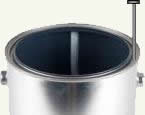Starting To Paint:
There is a definite order to painting a room. If you are painting the ceiling as well as the walls, the ceiling should be painted first.
Note: Always place plastic, cardboard or other disposable material under paint cans and paint trays!
Note: Do not allow paint brushes or rollers to sit in wet paint as this will destroy the pile on the rollers and the bristles of the brushes.
Note: Always put lids back on paint cans after pouring out a quantity of paint. For brushing, it is best to pour the paint into a small container rather than painting directly out of the can.
Note: After pouring paint, paint always remains in the small trough around the top of the can. To alleviate this problem, which can make it very difficult to replace the lid without splattering paint everywhere, use a 3 1/2 or 4 inch nail to make 3 or 4 holes around the circumference of the paint can lid trough, as shown in Figure 8. This will allow the paint to drip back into the can.

Figure 8 - Nail holes in trough of paint can
Note: Make sure that the paint is thoroughly mixed before putting it on the wall. Failure to do so can lead to different tones of paint throughout the paint can.
Ceilings:
Rollers do not do well on the edges where walls meet ceilings or where walls meet walls. Because of this it is necessary to use a paint brush to create a painted frame, approximately 2 to 3 inches around the perimeter of the ceiling. Providing the ceiling paint is the same base paint as the walls, there is no reason to use masking tape to create a true separation between the walls and the ceiling at this time. Small amounts of paint that may end up on the wall from the brush will be covered when the walls are painted.
Use a paint brush that is made for the base paint you are using. Some paint brushes are designated for both oil and water (latex) based paints while others work only on one or the other. A quality brush makes painting a lot easier and provides a better overall finish.
Once you have painted the perimeter of the ceiling (in some cases, it may be necessary to apply two coats of perimeter paint, even though you only need one coat of paint over the rest of the ceiling) you can commence to complete the ceiling painting using a roller (see paint rolling tips). Start in a corner and work across the narrowest part of the room, returning to the starting point of the row after you reach the far wall.
The use of an extension handle, as shown in Figure 9, on the paint roller will avoid the need to continuously climb up and down ladders.

Figure 9 - Paint roller extension handle
When applying the paint up to the edges of the ceiling, try to cover as much of the framing paint that you applied. This will produce a much better finish.
If you have tucked any ceiling fixture wires into their electrical boxes you should be able to roller right over the electrical box, without getting paint on wires.
Walls:
Do not attempt to paint the walls until the ceiling paint has completely dried.
If you are adept at "cutting in", which is the technique of using a brush to paint edges without masking tape and without getting paint on the adjacent surfaces, you do not have to mask the edge between the walls and ceiling or around window and door frames. If you are a novice at painting, I highly suggest you take the time to apply masking tape to the ceiling, door frames and window trim, at the edge to give a clean, straight line. Use painters masking tape as shown in Figure 2. General purpose masking tape has a tendency to remove fresh paint when peeled off.
I find it most convenient to do all the masking, where walls meet ceilings, around door frames and window trim at the same time. Some individuals prefer to tape the specific area being painted, it really doesn't matter which method you use.
It is up to the individual on whether or not they are comfortable in painting the edge between the walls and floor without applying masking tape. If you have wood flooring I highly recommend using a 2 inch painter's masking tape around the floor perimeter.
Start in a back corner of the room (that way you are not continually walking past fresh paint as you are painting) working from ceiling to floor.
If you are painting door frames and/or window trim a different color than the walls it is best to paint the lighter color first, allowing the darker color to paint over any paint that may end up where it is not wanted.
Follow the guidelines under "paint rolling tips" to do the painting.
